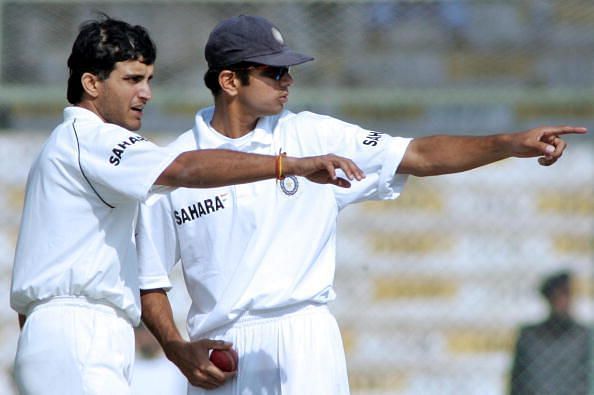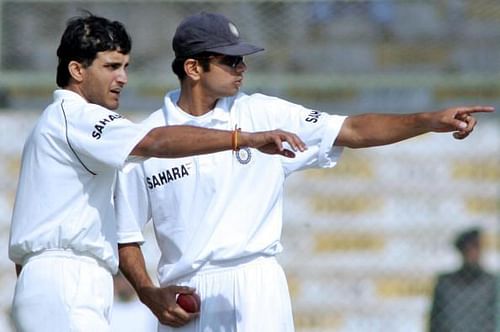
Rahul Dravid's life-changing advice to Sourav Ganguly

Sourav Ganguly and Rahul Dravid, two stalwarts of Indian Cricket who shared the dressing room for Team India for so many years, had different approaches whenever they found themselves in situations that demanded digging India out of a hole. While Dravid remained as firm and gritty as a wall absorbing all the pressure, Ganguly counter-attacked, thereby exemplifying the “offence is the best form of defence” approach.
While their approaches might have differed, their mentality during these predicaments was the same. Instead of believing that the odds were heavily stacked against them whenever India had its back against the wall, both viewed precarious situations as opportunities to take charge of the situation and deflect some of the pressure back on the opposition, doing Team India a service in the process.
But, believe it or not, had it not been for Dravid, Ganguly may never have cultivated this mentality and gone on to achieve as much success as he did and become the counter-attacking force that he was known to be.
In the following video, Ganguly talks about an exchange between the two former Captains during their formative years as cricketers.
According to Ganguly, the advice that Dravid gave him on reframing pressure situations as opportunities “made a massive difference to [his] life, to [his] game”. Let’s dissect why such a reframing or interpretation that seems minor and simple can have a profoundly positive impact.
The same situation could be looked at as a problem or as an opportunity. The word “problem” has a negative connotation attached to it while the word “opportunity” carries a positive one. When viewing a difficult situation as a “problem”, you’re approaching the situation on the backfoot and with a feeling of impending doom. On the other hand, when viewing such a situation as an “opportunity”, you’re approaching it on the front foot.
Looking at it as a problem cripples you as a result of which you’re tentative in your actions or stroke play. In cricketing terms, you’re caught in your crease. When you show too much respect to a problem, you allow it to intimidate you, rule over you, and eventually engulf you. In cricket as well, certain bowlers and batsmen command respect but giving them more respect than they warrant is playing into their hands. It’s then only a matter of time before that bowler claims your scalp or that batsman dispatches you to all corners of the park.
On the flip side, looking at a wobbly situation as an opportunity empowers you to take corrective action instead of crippling you in the face of uncertainty. It means that you truly believe that there is a realistic chance for you to play the role of a rescueman for your team. You back yourself to fight fire with fire as opposed to hoping for a miracle to magically turn things around for your team.
It was this attitude that also reflected in Ganguly’s aggressive captaincy style. In cricket, especially in Test matches, a few 50-50 moments going against you can cost you the game. Whenever the opposition was even remotely under pressure, he’d go for the kill lest the opposition claws their way back into the match. Whenever Ganguly sniffed an opening, he’d grab it by the scruff of its neck to prevent it from slipping away.
While Dravid may have instilled this mentality in Ganguly, Ganguly was responsible for doing so in the young crop of Indian players that he was leading during the formative years of his captaincy.
We all know it was Dada who had convinced Sehwag to open the batting. But not everyone might be aware of the manner in which he succeeded in convincing a hesitant Sehwag to do so. In a recent interview, Sehwag had shared what Ganguly had told him that instilled confidence in Sehwag to bat up the order:
“I will give you three to four innings as an opener. Even if you fail, you will continue to play. And before I drop you, I will again give you a chance in the middle (order)”.
You see why Sehwag couldn’t refuse such a deal? The proposed deal presented him the opportunity to shine as an opener and make that vacant spot his own. Thus, the upside was unlimited. The downside, on the other hand, was limited. If Sehwag flattered to deceive in the three to four innings that he would get as an opener, he’d still get opportunities in the middle order. This unlimited upside and very little downside that the deal presented allowed Sehwag to view Ganguly’s suggestion as an opportunity as opposed to as a do-or-die or make-or-break situation which, if not made the most of, would result in Sehwag being sidelined.
We’ve spoken enough about the merits of this mindset. Let’s now shift gears and talk about how you can practice such a mindset.
You don’t just turn on a switch after which you start reframing all problems as opportunities. You cultivate such a mindset and attitude through deliberate practice. With more and more repetitions under your belt, you become more and more accustomed to this way of interpretation.
One of the ways in which you can cultivate this empowering mindset is by viewing life or your life’s primary endeavour as a game, or better still as a series of games.
When we start taking ourselves or life way too seriously, we approach all the tests that life throws our way with a constant undercurrent of trepidation. We fear that the outcome of our actions may not materialize in our favour. As a result, we are either tentative in our actions or we shy away from taking action altogether in order to prevent the pain that would stem from the possible failure.
On the contrary, when we treat the series of tests that life flings our way as a series of games, we realize that we could lose multiple games but still end up clinching the series. Even after being 0-3 down in a 7-match series, there’s some hope to seal the series 4-3. While in a 7-match series in which you trail 0-3, the 4th game of the series is a do-or-die encounter, there is no limit to the number of games you play in life. Thus, no one game acts as a make-or-break, which means that a comeback is always on the cards.
Moreover, viewing a test or a challenge as a game allows you to enjoy the process as well. What fun is it to achieve the desired outcome without enjoying the process leading up to the outcome. The attitude we assume while playing a video game serves as a good analogy. Regardless of how difficult you’re finding it to level up, you continue to take cracks at it. When you do manage to level up, you eagerly look forward to vanquishing the next challenge even though it’ll likely be tougher. Why is it that our approach, in this case, is governed by such a positive mindset? 1. Because we treat it as a game since it’s quite literally a game, and 2. It’s never really “Game Over” as a video game presents unlimited opportunities to start afresh. View life through a similar lens i.e. as a never-ending series of games that continue to provide opportunities to level up.